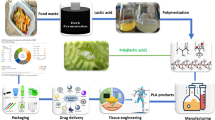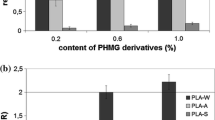Abstract
Out of 25 Amycolatopsis strains, 15 formed clear zones on agar plate emulsified with poly(L-lactide) (PLA), suggesting a large distribution of PLA degraders within this genus. The clear zones were also observed with other polyesters and silk fibroin plates. In liquid cultures of PLA degraders, there were strains with and without ability to assimilate degradation products like L-lactic acid.
Similar content being viewed by others
References
Ikura Y, Arai H, Kudo T (1998) Isolation and some properties of actinomycetes that utilize polylactate. In: Int. Symp. on Biological Polyhydroxyalkanoates '98. Program, Abstracts and List of Participants, September 9–11, Wako, Japan, p. 57.
Lechevalier MP, Prauser H, Labeda DP, Ruan J (1986) Two genera of nocardioform actinomycetes: Amycolata gen. nov. and Amycolatopsis gen. nov. Int. J. Syst. Bacteriol. 36: 29–37.
Nishida H, Tokiwa Y (1993) Distribution of poly(β-hydroxybutyrate) and poly(ε-caprolactone) aerobic degrading microorganisms in different environments. J. Environ. Polym. Degrad. 1: 227–233.
Pranamuda H, Tokiwa Y, Tanaka H (1995) Microbial degradation of an aliphatic polyester with a high melting point, poly(tetramethylene succinate). Appl. Environ. Microbiol. 61: 1828–1832.
Pranamuda H, Tokiwa Y, Tanaka H (1997) Polylactide degradation by an Amycolatopsis sp. Appl. Environ. Microbiol. 63: 1637–1640.
Reeve MS, McCarthy SP, Gross RA (1994) Polylactide stereochemistry: effect on enzymatic degradability. Macromolecules 27: 825–831.
Strydom DJ, Haylett T, Stead RH (1977) The amino-terminal sequence of silk fibroin peptide Cp — a reinvestigation. Biochem. Biophys. Res. Commun. 79: 932–938.
Suyama T, Tokiwa Y, Quinchanpagdee P, Kanagawa T, Kamagata Y (I998) Phylogenetic affiliation of soil bacteria that degrade aliphatic polyesters available commercially as biodegradable plastics. Appl. Environ. Microbiol. 64: 5008–5011.
Tansengco ML, Tokiwa Y (1998) Comparative population study of aliphatic polyesters-degrading microorganisms at 50 °C. Chem. Lett. 1998: 1043–1044.
Tokiwa Y, Konno M, Nishida H (1999) Isolation of silk degrading microorganisms and its poly(L-lactide) degradability. Chem. Lett. 1999: 355–356.
Torres A, Li SM, Roussos S, Vert M (1996) Screening of microorganisms for biodegradation of poly(lactic acid) and lactic acid-containing polymers. Appl. Environ. Microbiol. 62: 2393–2397.
Williams DF (1981) Enzymic hydrolysis of polylactic acid. Eng. Med. 10: 5–7.
Author information
Authors and Affiliations
Rights and permissions
About this article
Cite this article
Pranamuda, H., Tokiwa, Y. Degradation of poly(L-lactide) by strains belonging to genus Amycolatopsis . Biotechnology Letters 21, 901–905 (1999). https://doi.org/10.1023/A:1005547326434
Issue Date:
DOI: https://doi.org/10.1023/A:1005547326434




